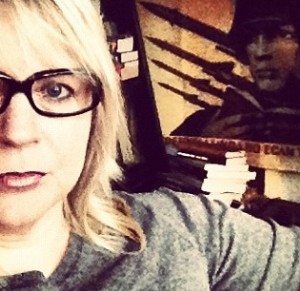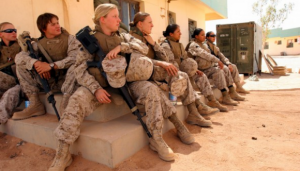War and Disability
By Sandra Trappen
Problem
According to Chris Hables Gray, “wars do make men” (1997:295). And to this I might add, they make women, too. That said, when we consider gender in relation to war and disability, there are—to the detriment of all women—not enough feminists, let alone disability scholars who are feminists, exploring these issues. It’s as if to talk about war is to talk “the boys’ talk.”
Yet in avoiding the subject, either by choice or by default, women are allowed to remain invisible. Presently, I’m engaged in empirical research that looks at these issues. The study was originally conceived out of a desire to counter mainstream celebratory discourses that traffic in the apotheosis of wounded soldiers, the vast majority of whom are men. Treading the path of hagiography, fantasy, and myth-making, the distinguishing trademark of most war writing, precludes critical inquiry and renders impossible constructive engagement with alternative critical discourses—feminist discourse included— that might contribute to an understanding of how war casualties, disability, and gendered assumptions about bodies and power have, over the course of time, become infrastructural to ongoing war.
A number of problems surface here, the most obvious of which is the near erasure of women’s experiences. But there are other problems too, which remain hidden in the background because conventional narratives that “celebrate” wounded soldiers preclude critical thinking about these issues, which are complex. One finds beyond the simple homilies a story that unites the history of the “great men of war” with the “great men of medicine.” Feminist methods can write a different narrative and in the process potentially raise awareness regarding the degree to which injuries and disabilities from war and militarism imbricate violence within social spaces and social logics not traditionally linked. Psychological terror, street violence, incarceration, human slavery, trafficking in women—all offer testimony to the permeability of boundaries where war is concerned. Ultimately, I want to suggest we think about war as a relational ontology; one that organizes violence and bodily experiences through various means and practices distributed across social locations.
Another problem is that disability studies is far too restricted theoretically in its approach to understanding “the body” that is disabled. Identity critiques with regard to ableism characterize the vast majority of literature, which in spite of its many contributions overall, fail to escape the ossifying tendency to frame issues through competing dualisms like abled/disabled, normative/non-normative, and public/private. Intersectionality theories thus appear almost edgy by comparison.
History Meets Biography
The fact that I am a woman, a former Army officer and female soldier, should be incidental; however, gender is not incidental among the cadre of writers, experts, and critics who claim war as their realm of expertise. Notwithstanding recent legislative efforts to legitimize women’s participation in direct combat, war is understood to be the ultimate proving ground for men. Men, as such, are historically associated with the realms of life and mind, and women are confined to the lesser domestic realms, including the body. Traditional war studies and histories of disability have favored male subjectivity, thereby occluding female subjectivity. Masculine epistemologies thus tend to dominate how we think and feel about war, injury, and disability.
In the interest of full disclosure, as one whose body continues to adjust to injury, I should add that I draw from some of my own experiences to reflexively consider what it feels like to be and live in a body that is wounded and disabled by war; for I too find that I am at times simultaneously empowered and disempowered by experiences of pain, suffering, estrangement, and ambiguous embodiment, as are the wounded soldiers whose stories comprise my study. Issues of gender and disability thus are unavoidably implicated in my interest to pursue this project. This adds yet another dimension to my analysis of combat injury and disability that looks at how not only gender but also race and class differences travel on the body and enter domains of social control.
Discussion
In the years following the attacks of 9/11— years that mark what is thought to be the beginning of the “war on terror” — the United States deployed more than 2.5 million soldiers into combat operations in Iraq and Afghanistan. Like those who departed for war throughout history, large numbers of military men and women did not return home in a state of health and well-being comparable to their pre-deployment health status. When we look at this problem strictly in terms of casualty statistics, it is apparent that many were injured and disabled rather than killed. But more than this, a preponderant number of the losses reflect civilian casualties that consist of women and children. In spite of these outcomes, injured soldiers as a group still comprise a significantly large and regrettably “fresh” population that might be studied so we might learn more about the social dimensions of injury, as well as illness and disability.
Thus, we might ask: How are injury and disability experienced by this group? How do the experiences of this group compare to the population of disabled people who are not soldiers and veterans? How are masculine epistemologies reflected in the processes of “making war” and “making bodies?” What can disability tell us about what it means to be a man or woman who is at war? And finally, why do “parts” matter?
I should clarify that in pursuing a line of questioning that privileges a narrative singling out soldiers’ bodies, it is not my intention to diminish the experiences and losses of non-soldier identified individuals; nor do I mean to reify bodies and subjects, and thus by extension privilege the human. I am not arguing that wounded soldiers’ bodies are essentially different or more worthy of study than other disabled bodies. On the contrary, my analysis illustrates how conceptual and identity categories, as they relate to war, are in many respects inherently unstable. Disabling injuries that are the result of war, furthermore, are clearly not “new” developments. But this is not to say that war, injury, and disability have remained the same. Recent trends indicate that combat injuries among soldiers have decreased over time; incidents of wounding are not the life-threatening events they once were.
Addressing the long-term costs associated with physical and mental disability poses a greater challenge now compared to previous wars, because many among the wounded (soldiers in particular) are surviving injury, due to improvements in battlefield medicine and technology. Facilitating their rehabilitation and social reintegration thus ranks among the significant social problems that countries will face in the coming decades. Such a process, in my view, suggests the bodily changes wrought by war are fundamentally ontological—the wounded soldier is the classic “canary in the coal mine”—and while they might not be statistically representative, we still might look to them as a means to prognosticate developments in other bodies and populations.
Questions remain about how one might theorize the complex ontologies of subjectivity produced in war, including disabled subjectivities; ontologies characterized by intersecting material and immaterial relations that are further distinguished by boundaries and borders between bodies, human and non-human, which are no longer fixed, but rather are dynamic, fluid, and permeable (Blackman, 2012). In pursuing my own research, I found it necessary to step outside the bounds of traditional disability identity critiques in order to address what was missing from the conversation: namely, a critical vocabulary that did not rely on linguistic oppositions to talk about disability; likewise, one that did not limit discussion to issues of identity, but could express the complexity that distinguishes people disabled by war wounds. For such bodies are not mere containers or signifying objects that are fashioned (and re-fashioned) to make identity claims; they are people who inhabit their bodies as fully embodied beings.
Thus, without reifying the opposition of domestic/public, masculine/feminine, mind/body, human/non-human, self/other, and inside/outside, I want to shift the focal point of discussions about war and the body away from more traditional state-centric conflict approaches focused on battlefields, to a feminist critique that looks at how war’s powers of invasion simultaneously inhabit the intimate spaces of the body. In other words, I am suggesting it is possible to achieve a richer understanding of war, combat casualties, and disability by considering the different ways the body might be received given its intimate relationships to war.
 The challenge, I think, from the perspective of disability theory and critique, is how to go about theorizing disability in connection with war in such a way that one might avoid mind-body traps, competing dualisms, and other limitations bound up with representational discourses that focus on identity. This task is made more difficult by the fact that there is no single literature that deals with the issue of combat injuries and disability. Gerber (2012), among others, has argued that in opting for a direction driven by the focus of cultural studies on critical race theory, queer theory, literary theory, and gender theory, the genre has privileged issues of identity to the detriment of critiquing disability in connection with the social history of war. In some cases, as Gerber points out, disabled veterans have themselves been problematized. This pattern is similarly reproduced in the socio-medical literature, where empirical studies tend to be driven by a policy focus. Empirical studies are limited and when they do occur, the focus leans more toward informing government program initiatives (i.e., veterans’ social welfare benefits, housing, substance abuse, rehabilitation, and social reintegration).
The challenge, I think, from the perspective of disability theory and critique, is how to go about theorizing disability in connection with war in such a way that one might avoid mind-body traps, competing dualisms, and other limitations bound up with representational discourses that focus on identity. This task is made more difficult by the fact that there is no single literature that deals with the issue of combat injuries and disability. Gerber (2012), among others, has argued that in opting for a direction driven by the focus of cultural studies on critical race theory, queer theory, literary theory, and gender theory, the genre has privileged issues of identity to the detriment of critiquing disability in connection with the social history of war. In some cases, as Gerber points out, disabled veterans have themselves been problematized. This pattern is similarly reproduced in the socio-medical literature, where empirical studies tend to be driven by a policy focus. Empirical studies are limited and when they do occur, the focus leans more toward informing government program initiatives (i.e., veterans’ social welfare benefits, housing, substance abuse, rehabilitation, and social reintegration).
Findings
Findings from my study indicate that disability is, at least on some levels, productive to the collective practices of knowledge making, wound-making, and body-making, as these are not isolated and dissimilar productions. Incorporating the stories of the soldiers themselves was, I found, also important to theorizing the nature of disabling injury. Personal narratives and histories were marked by a concerted effort to “bring the body back in,” as story telling emphasized the carnal aspects of having and being a body disabled by war. Bodies are cut open. Friends bleed. And many are wounded to the point of death.
Yet even still, the body itself remains elusive. For the anatomical logic of war is such that, regardless of how many rifles, bullets, bayonets, and knives might render skin from bone, not even a mountain of casualties can imprint the psyche of the uninitiated in such a way that they might fully grasp the brute nature of slaughter—that alone remains an exclusive possession of those who are witness to war. Consequently, representational narratives and practices that focus simply on identity inevitably fall short of well-intentioned aims that purport to help us know how to see and to feel (Kaplan, 2013). They are precluded from accounting for the embodied nature of wounded and disabled subjectivity. Thus, we are only ever left with a lingering sense of what happens to a body that is wounded in war.
Conclusion
Presently, simplified analysis that merely takes into account binary understandings of “abled/disabled” and “male/female” bodies renders it nearly impossible to understand how war objectifies and produces bodies across a more diverse relational spectrum. One way to overcome these limitations is to combine identity critique with more dynamic non-representational thought paradigms. The turn to affect in critical theory, body theory, psychoanalytic theory, and the new materialism theories might all be called upon to explore how knowledge and power continue to imbricate the complex topographies of mind and body bound up in disability studies and the political economy of bodies produced by war. Training a feminist lens on the problem of prevailing dualisms here makes it possible to see how injury, illness, and disability potentially engender new and different forms of oppression, as recovery and rehabilitation are often achieved through enhanced means of bioscientific and biotechnological control. In this instance, embodied contradiction is both the marker and the result of contemporary power configurations investing in the making of gendered bodies to organize society for the production of ongoing war. Feminist scholars might thus continue to debate the entanglement of body politics and state politics by effectively linking issues of health, injury, and disability to larger issues of militarization and the social organization of violence.
_________________________________________
 Sandra Trappen is a Ph.D. candidate in Sociology at the City University of New York Graduate Center and Adjunct Professor of Sociology at Queens College, CUNY. Presently, she is completing her dissertation, teaching, and writing full time. You can learn more about her work at sandratrappen.com. And you can follow her on Twitter @SandraTrappen.
Sandra Trappen is a Ph.D. candidate in Sociology at the City University of New York Graduate Center and Adjunct Professor of Sociology at Queens College, CUNY. Presently, she is completing her dissertation, teaching, and writing full time. You can learn more about her work at sandratrappen.com. And you can follow her on Twitter @SandraTrappen.





3 Comments